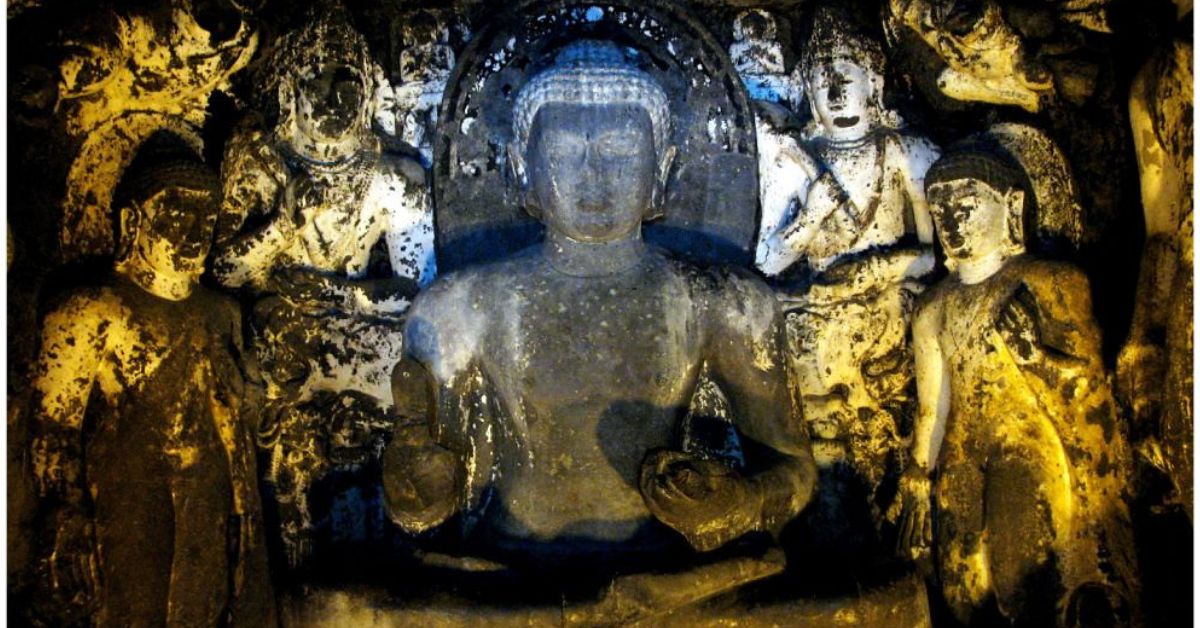In Maharashtra, the Ajanta and Ellora Caves, remarkable rock-cut monuments dating to the 2nd century BCE, stand as testaments to India’s profound cultural and artistic heritage. Primarily Buddhist monastic complexes, the Ajanta Caves are celebrated for their intricate paintings and sculptures. Each cave, carved into the hillsides, narrates a unique story through vibrant Jataka tales and serene Buddha portrayals. Together, these caves offer a captivating window into ancient India’s artistic, religious, and historical evolution.
How to Reach:
Traveling by Air:
The closest airport serving both Ajanta and Ellora Caves is Aurangabad Airport (Chhatrapati Sambhaji Maharaj Airport). Located approximately 99 kilometers from Ajanta and 30 kilometers from Ellora, the airport offers frequent connections to major Indian cities like Mumbai, Delhi, and Hyderabad. Taxis and local transportation are readily available at the airport for onward travel to the caves.
Traveling by Train:
Aurangabad Railway Station serves as the nearest railhead, boasting excellent connectivity to major Indian cities. Trains from Mumbai, Delhi, Hyderabad, and other key locations arrive regularly at Aurangabad. Upon arrival at the station, taxis, buses, and other local transportation options can be used to reach the caves.
Best Time to Visit:
Winter:(October – March)
Pleasant weather makes winter the prime season for visiting Ajanta and Ellora Caves. Comfortable temperatures between 15°C and 30°C allow for extended exploration. Clear skies ensure excellent lighting for capturing the caves’ intricate details in photos. This period also coincides with the Ellora Festival, featuring classical music and dance performances, enriching your visit with a vibrant cultural touch. Pack light layers for cooler mornings and evenings.
Summer: (April – June)
Summer in Maharashtra can be hot, with temperatures reaching 25°C to 35°C or even higher. While the heat can be intense, exploring the caves during the cooler mornings or late afternoons can be more manageable. This season sees fewer crowds, offering a more private and relaxed exploration experience. Additionally, you might find better deals on accommodation. Staying hydrated and wearing sunscreen, hats, and lightweight, breathable clothing is essential for coping with the summer heat.
Attractions:
Ajanta Caves, Ajanta and Ellora Caves
Ajanta Caves: Caves 1 to 10
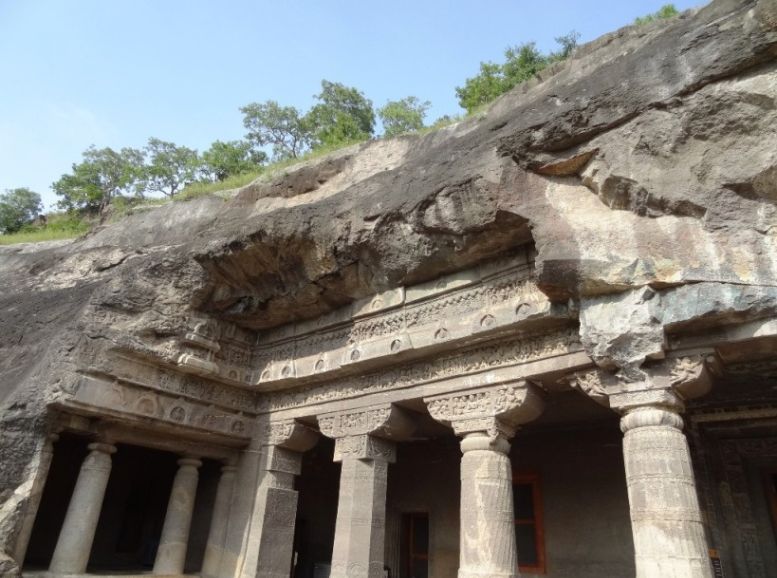
The first five caves at Ajanta are a dazzling introduction to ancient Buddhist art. Frescoes and sculptures explode with color and detail, whispering stories from a bygone era. Cave 1 stuns with life-sized portraits of the Bodhisattvas Padmapani and Vajrapani. Their intricate forms embody the artistic mastery of the time. Look closely, and you’ll find scenes from Buddha’s life and the Jataka tales carved into the very walls, offering a window into the heart of Buddhist beliefs.
Cave 2 picks up the artistic baton, its vibrant murals bursting with Jataka tales. Gaze upwards to admire the beautifully preserved ceiling paintings, adding another layer of wonder to this sacred space. Though unfinished, Cave 3 hints at the ambitious vision of the sculptors. Move on to Cave 4, one of Ajanta’s grandest monasteries. An elaborate facade welcomes you, leading to a central shrine housing a majestic Buddha statue. Finally, Cave 5, another monastery, exudes serenity with its intricate carvings. Together, these caves weave a captivating tapestry of artistic and spiritual legacy, a testament to the dedication of ancient Buddhist monks.
Ajanta Caves: Caves 6 to 10
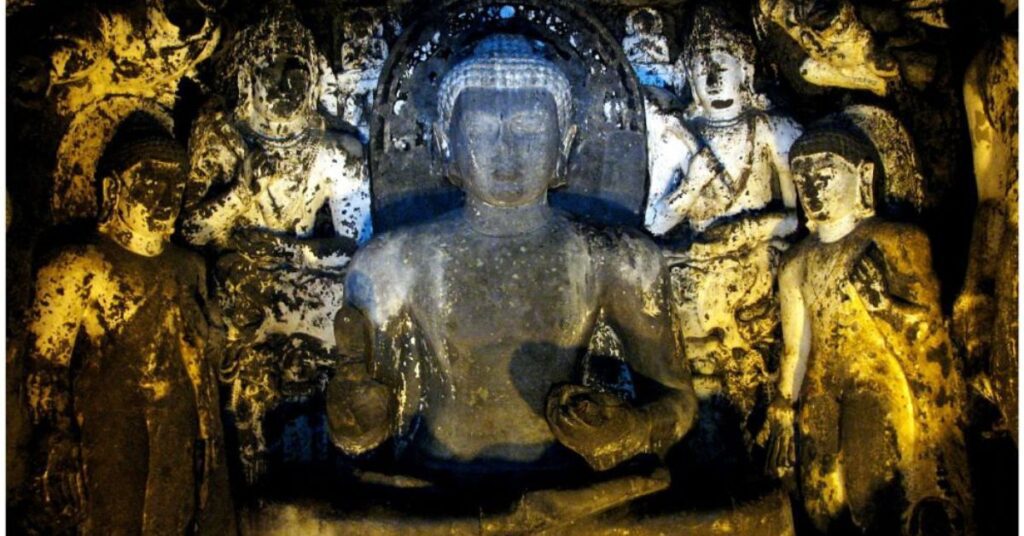
The wonders of Ajanta keep unfolding as we explore Caves 6 to 10. Cave 6 stands out for its unique two-story design. Step inside and marvel at the intricately carved doorways and pillars on the lower level. Ascend to the upper level to discover a treasure trove of fine sculptures and a central shrine housing a serene Buddha statue.
While smaller, Cave 7 offers a different kind of magic. Delicate carvings grace the walls, creating a peaceful atmosphere perfect for quiet contemplation. Cave 8 takes us back in time, showcasing the simpler style of one of Ajanta’s earlier excavation phases.
Next, we enter Cave 9, a vast chaitya hall (prayer hall) – one of the earliest at Ajanta. Natural light bathes the interior through a unique horseshoe-shaped window. A majestic stupa stands at the center, while the walls come alive with detailed paintings depicting scenes from Buddha’s life.
Cave 10, also known as the Vishvakarma Cave, echoes the grandeur of Cave 9 with its impressive size and chaitya hall design. Exquisite carvings and surprisingly good acoustics make this cave a haven for meditation and chanting. Look closer at the murals adorning the walls – they narrate different chapters in Buddha’s journey, a testament to the rich artistic legacy of this ancient Buddhist community.
Ajanta Caves: Caves 11 to 17

The journey through Ajanta continues to amaze as we explore Caves 11 to 17. Stepping into Cave 11, a vihara (monastery), you’re greeted by a spacious hall and a central shrine dominated by a large Buddha statue. The calmness of the space is amplified by the intricate carvings that grace the walls, depicting various Buddhist figures and symbols.
Cave 12, another vihara, offers a more understated beauty. Its central hall and surrounding cells for monks reflect a life of simplicity and meditation. This theme is echoed in Caves 13 and 14, smaller spaces adorned with beautiful carvings that hint at the ascetic practices of the monks who resided here.
A grand entrance and a meticulously carved facade set Cave 15 apart. Stepping inside, you’ll find detailed sculptures and a central shrine with another impressive Buddha statue. The artistry of the period shines through the intricate carvings that adorn the pillars and walls.
Nicknamed the “Cave of the Princess,” Cave 16 holds immense significance. Its walls are a treasure trove of detailed narrative paintings that breathe life into Buddhist stories, including the captivating scenes from the Mahajanaka Jataka. The vibrant colors and intricate details transport you back in time, offering a glimpse into the culture and daily life of ancient Buddhists.
Ajanta Caves: Caves 18 to 29
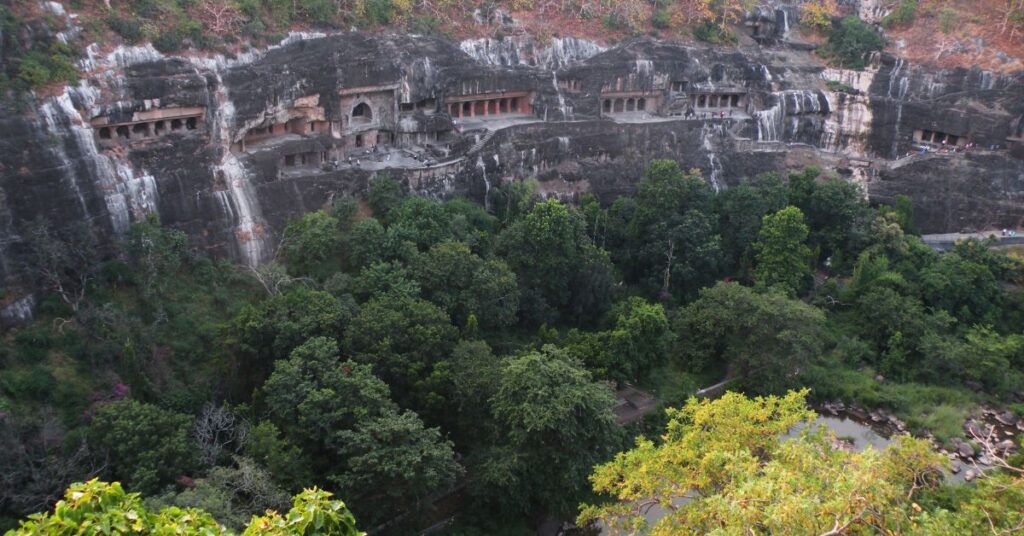
Ajanta Caves 18 to 29 offer a deeper dive into this UNESCO marvel. Cave 18, a tranquil vihara (monastery), sets the tone with its simple elegance, perfect for meditation. Cave 19, a grand chaitya hall, bathes a central stupa in natural light and boasts intricate carvings and paintings depicting Buddha’s life. Cave 20 showcases evolving artistic styles with its expansive hall and detailed sculptures. The smaller Cave 21 offers a glimpse into monastic life with its adorned interiors. Caves 22 to 29, a mix of viharas and chaityas, each with unique features and embellishments, solidify the enduring legacy of Buddhism in India. Exploring these caves allows visitors to connect with India’s rich heritage and spiritual traditions on a deeper level.
Ellora Caves:
Ellora Caves: Caves 1 to 10
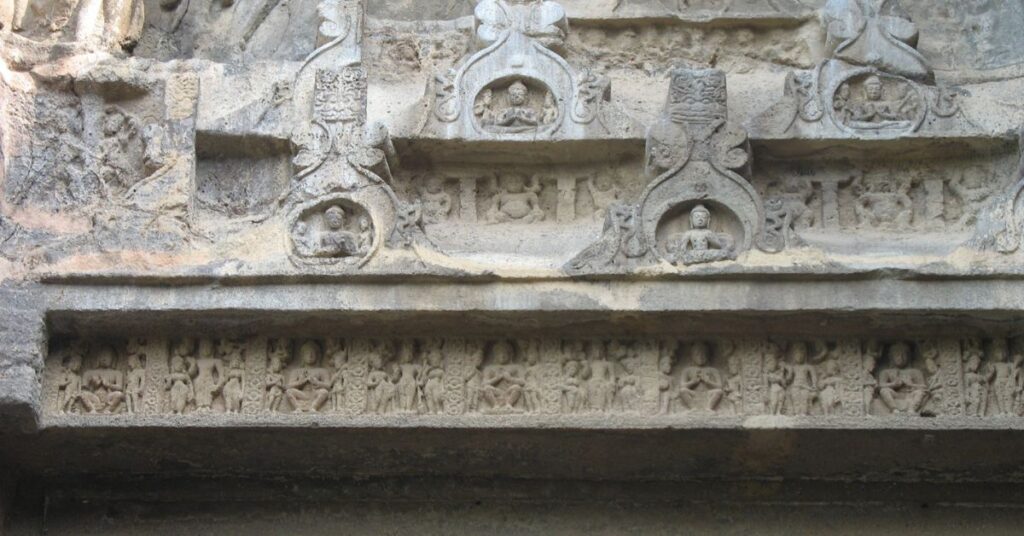
The first ten caves at Ellora unveil a fascinating world steeped in Buddhist artistry and spirituality. Cave 1 starts simple, a vihara with a central Buddha statue. But as you explore further, the complexity grows. Cave 2 boasts a spacious hall with intricately carved pillars and detailed sculptures of Buddhist deities. Cave 3 follows a similar layout, showcasing the mastery of carving entire monasteries from the rock face. Cave 4 stuns with its size – one of the largest viharas at Ellora, richly decorated with Buddhist motifs. Cave 5 features a grand assembly hall, its walls adorned with carvings depicting Buddha’s life. Caves 6 and 7 offer contrasting experiences. Cave 6 is a two-story marvel, while Cave 7 captivates with its delicate carvings. Cave 8, significant for its historical value, represents the earlier excavation phases. Finally, Cave 9, an early chaitya hall, features a unique window that illuminates the stupa and detailed paintings. Cave 10, or Vishvakarma Cave, echoes the grandeur with its impressive acoustics and murals depicting Buddha’s life. These caves offer a glimpse into the artistic and spiritual legacy of the ancient Buddhist communities.pen_sparktunesharemore_vert
Ellora Caves: Caves 11 to 20
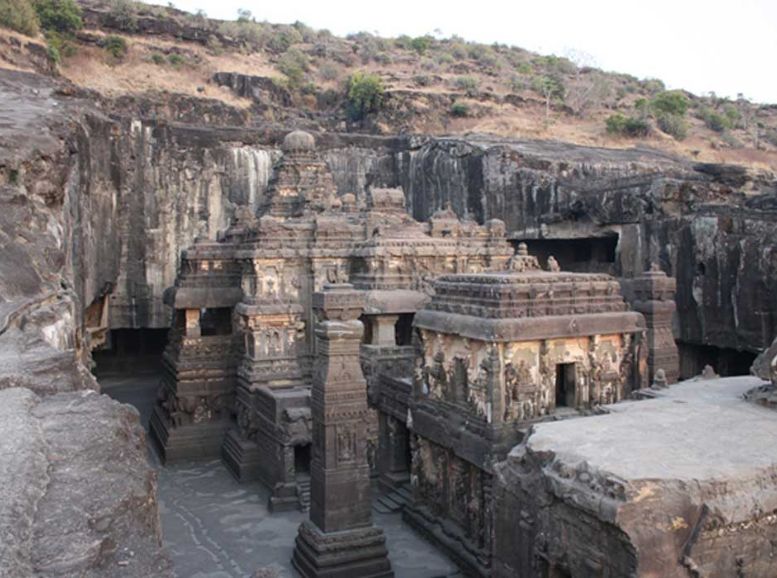
Ellora Caves 11 to 20 unveil a fascinating shift from predominantly Buddhist to Hindu influences. Cave 11, a two-story structure with intricate shrines, blends Buddhist and early Hindu elements. Cave 12, another multi-story marvel, boasts elaborate carvings and shrines dedicated to various deities. Caves 13 to 15, though smaller, showcase detailed sculptures and evolving architectural styles. Cave 14 stands out with beautiful pillars and a central Buddha statue. The magnificent Kailasa Temple (Cave 16) takes center stage, a monolithic marvel dedicated to Lord Shiva, showcasing intricate sculptures and the peak of rock-cut architecture. Caves 17 to 20 continue the Hindu narrative with detailed carvings and shrines. Cave 17 features a large hall with Hindu deities, while Caves 18 and 19 are intricately decorated. Cave 20, with its elaborate entrance and serene atmosphere, marks the end of this section, leaving visitors with a deep sense of artistic and spiritual fulfillment.
Ellora Caves: Caves 21 to 34
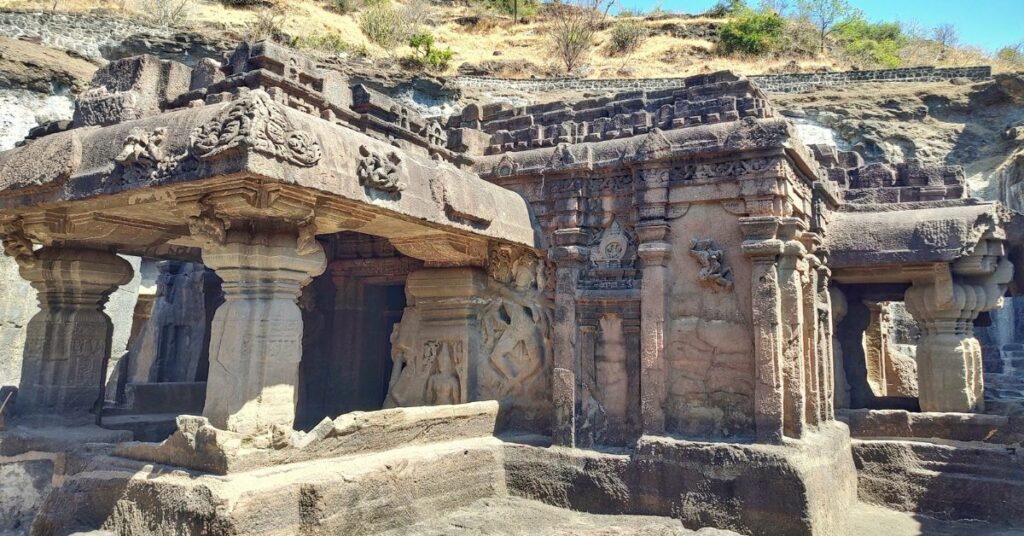
The southern stretch of Ellora Caves (21-34) unveils a Jain wonderland. Dedicated to meticulous craftsmanship and Jain beliefs, these caves are a testament to the artistry of ancient artisans. Cave 21, also known as Rameshvara Cave, is a significant Jain temple adorned with intricate sculptures of Tirthankaras and river goddesses at the entrance, hinting at the aesthetics within. Caves 22 to 27 continue the tradition with beautifully carved pillars, ornate ceilings, and sculptures depicting Jain deities, all exuding a serene ambiance. Cave 28, or Indra Sabha, breaks the mold with elaborate carvings and a central Tirthankara statue. Its walls depict Jain cosmology and myths, offering deeper insights into the religion. Caves 29 to 34 complete the Jain section, each showcasing unique architectural features and decorative motifs. Cave 32, in particular, features a large prayer hall with intricately carved pillars and ceilings, creating a harmonious space for meditation.
Local Experiences:
Tantalize Your Taste Buds: Savor Maharashtrian specialties like Vada Pav, Misal Pav, and Poha at local restaurants and street vendors.
Shop for Local Treasures: Explore bustling markets for unique handicrafts like Paithani sarees, Bidriware, and Ajanta-Ellora themed souvenirs.
Immerse Yourself in Culture: Witness traditional music and dance performances showcasing Maharashtra’s rich heritage, often held during festivals.
Explore Rural Life: Venture into nearby villages to experience daily life and interact with locals, gaining insights into traditional farming and artisanal practices.
Ellora Festival: If your visit coincides with the winter festival season, don’t miss the Ellora Festival. Held against the majestic backdrop of the caves, it features captivating classical music and dance performances.
Aurangabad City Tour: Embark on a city tour of Aurangabad to discover historical sites like Bibi Ka Maqbara, Daulatabad Fort, and Aurangabad Caves, each offering a glimpse into the region’s fascinating past.
Travel Tips:
Ideal Visit Timing: Aim for the cooler months, October to March, for comfortable exploration in pleasant weather.
Opening Hours: Note that Ajanta Caves are closed on Mondays and Ellora Caves are closed on Tuesdays. Double-check specific timings before your visit.
Enhancing Your Experience: Consider hiring a local guide to unlock the caves’ history, architecture, and stories, enriching your exploration.
Footwear: Comfortable, sturdy shoes are essential for uneven terrain and climbing cave steps.
Photography: While photography is allowed at both sites, some caves may restrict flash photography. Always respect signage and guidelines.
Entry Fees: Separate entry fees apply for Indian and foreign visitors at both caves. Carry enough cash as card payments might not be accepted.
Conclusions:
A UNESCO World Heritage Site, the Ajanta and Ellora Caves offer a profound journey through Indian art and history. Xplro.com can guide your exploration, ensuring a seamless experience. Witness intricate Ajanta frescoes depicting Buddha’s life, and marvel at Ellora’s monumental rock-cut temples honoring diverse deities. Each cave tells a unique story of artistry and faith, leaving a lasting impression. Beyond the caves, delve into local markets for handicrafts, savor Maharashtrian cuisine, and be captivated by cultural performances. Plan your visit with Xplro.com to discover the best time to go, find travel tips, and witness history carved in stone. Ajanta and Ellora stand as testaments to India’s enduring artistic legacy and spiritual depth, inviting you to connect with the past and marvel at human ingenuity.
FAQs:
What are Ajanta and Ellora Caves?
- Ajanta and Ellora Caves are ancient rock-cut cave complexes located in Maharashtra, India, renowned for their exquisite sculptures and paintings. Ajanta primarily features Buddhist caves, while Ellora comprises Buddhist, Hindu, and Jain caves.
Where are Ajanta and Ellora Caves located?
- Ajanta Caves are situated near Aurangabad, approximately 100 kilometers northeast of the city, while Ellora Caves are around 30 kilometers northwest of Aurangabad.
What is the best time to visit Ajanta and Ellora Caves?
- The best time to visit is from October to March when the weather is cool and pleasant, ideal for exploring the Ajanta and Ellora caves. Avoid visiting during the peak summer months (April to June) due to the hot temperatures.
How long does it take to explore Ajanta and Ellora Caves?
- Plan to spend at least one full day at each site to explore the caves thoroughly. Ajanta has around 30 caves, and Ellora has approximately 34 caves, each with its own unique architecture and artworks.
Are Ajanta and Ellora Caves UNESCO World Heritage Sites?
- Yes, both Ajanta and Ellora Caves are designated as UNESCO World Heritage Sites, recognized for their cultural and historical significance.
What are the opening hours of Ajanta and Ellora Caves?
- Ajanta Caves are open from 9:00 AM to 5:30 PM, closed on Mondays. Ellora Caves are open from 6:00 AM to 6:00 PM, closed on Tuesdays.
Is photography allowed inside Ajanta and Ellora Caves?
- Yes, photography is permitted inside the caves for personal use. However, there may be restrictions on using flash photography to preserve the ancient artworks.
How do I reach Ajanta and Ellora Caves from Aurangabad?
- Aurangabad is the nearest major city and transportation hub. You can reach Ajanta and Ellora Caves by hiring a taxi, taking a bus, or joining organized tours from Aurangabad.
Are there accommodation options near Ajanta and Ellora Caves?
- Yes, Aurangabad offers a range of accommodation options including hotels, resorts, and guesthouses catering to different budgets. Some visitors also stay in nearby villages for a more immersive experience.
What are the highlights of Ajanta Caves?
- Ajanta Caves are known for their intricate frescoes depicting the life of Buddha, Jataka tales, and vibrant murals showcasing ancient Indian artistry.
What are the highlights of Ellora Caves?
- Ellora Caves feature the impressive Kailasa Temple (Cave 16), a monolithic structure dedicated to Lord Shiva, along with Buddhist and Jain caves showcasing intricate carvings and sculptures.
Are guided tours available at Ajanta and Ellora Caves?
- Yes, guided tours conducted by knowledgeable local guides are available at both sites. Guides offer insights into the history, architecture, and cultural significance of the caves, enhancing the visitor experience.




